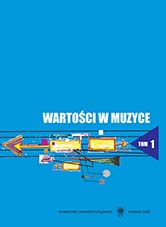Rola techniki dyrygenckiej w procesie kształtowania interpretacji utworu chóralnego w zespole amatorskim
The role of the conducting technique in the process of choral music interpretation formation in an amateur ensemble
Author(s): Aleksandra ZemanSubject(s): Music
Published by: Wydawnictwo Uniwersytetu Śląskiego
Summary/Abstract: The art of conducting developed through the centuries and its development was affected by the development of music as well as the growth of interpretation difficulties of music compositions. The contemporary conductor shows all the performance elements, like rhythm, metre, dynamics, tempo, phrasing and articulation by the movements of the hands, the baton or by miming. The conductor’s movement should be economical, dynamic, flexible, vivid, aesthetic, suggestive and expressive. The technique of conducting can also be regarded as the thought, the consciousness, the intuition of the conductor and the means and methods used to achieve the aim. The art of conducting lies not only in the reading of the lifeless and imperfect music notation. It is a synthesis of the conducting technique and the art of interpretation connected not only with the reproduction of the given music piece, but also with creating it. The vocal and vocal-instrumental music needs to be looked at from two perspectives: the perspective of music and the perspective of the word. The performer and the interpreter, at the same time, who undertakes the interpretation of a music piece, should first look for this music interpretation guidelines to be able to reach the true value of the piece of music.
Journal: Wartości w muzyce
- Issue Year: 2008
- Issue No: 1
- Page Range: 97-103
- Page Count: 7
- Language: Polish

